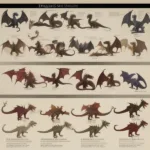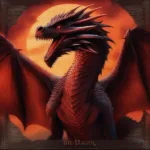The Dance of the Dragons, a pivotal period in Westeros’s history, holds a significant place in the narrative of Game of Thrones. This devastating civil war between Targaryen factions profoundly shaped the Seven Kingdoms, leaving a legacy felt even generations later. Understanding the Dance of Dragons is crucial for fully appreciating the complexities and foreshadowing within the Game of Thrones story. This comprehensive guide will delve into the key aspects of this historical event, exploring its impact on the characters and plotlines within the books and TV series.
The Dance of the Dragons: A Targaryen Civil War
The Dance of the Dragons, a brutal conflict that shattered the Targaryen dynasty’s seemingly invincible strength, involved a succession crisis. It pitted Rhaenyra Targaryen, the proclaimed heir designated by her father, King Viserys I, against her half-brother Aegon II Targaryen. This conflict, centered around the very question of who was the rightful heir to the Iron Throne, ignited a devastating war that plunged Westeros into chaos and bloodshed. The war showcased not only the fragility of power but also the immense destructive capacity of dragons, the ultimate symbols of Targaryen dominance.
Key Players in the Dance of the Dragons
The Dance of the Dragons saw numerous influential characters vying for power and survival. Beyond Rhaenyra and Aegon II, several prominent figures, including their supporters and their enemies, directly influenced the outcome. These pivotal players played critical roles in shaping the war’s course and the ultimate consequences for the Seven Kingdoms. Let’s explore some of these key players and their allegiances. We’ll also discuss their motives and impacts on the narrative.
- Rhaenyra Targaryen: The princess who believed herself the rightful heir to the Iron Throne, her claim challenged by Aegon II. Her supporters included powerful lords and ladies of Westeros.
- Aegon II Targaryen: The claimant to the throne, with a strong contingent of supporters who believed in his claim through legitimate succession.
- Otto Hightower: Hand of the King under Viserys I and a key architect behind Aegon II’s claim.
- Alicent Hightower: Aegon II’s mother, a shrewd political player with immense influence within the royal court.
- Daemon Targaryen: Rhaenyra’s husband, known for his brutality and ambition. A key military commander in the war.
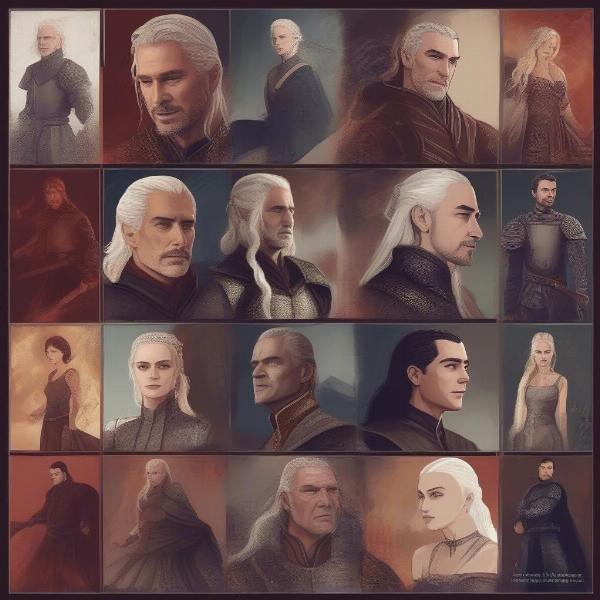 Key Players in the Dance of the Dragons
Key Players in the Dance of the Dragons
The Impact of Dragons on the Dance of the Dragons
The presence of dragons dramatically escalated the conflict. The dragons were not just symbols of power; they were weapons of immense destructive power, capable of incinerating armies and laying waste to cities. The use of dragons fundamentally altered the nature of warfare in the Dance of the Dragons, leading to unprecedented levels of destruction and loss.
Dragon Riders and Their Mounts
The dragons, and the riders who controlled them, became central to the military strategies during the Dance of the Dragons. The bonds between dragon and rider were crucial; a strong bond translated directly into battlefield prowess. The loss of dragons, or skilled dragon riders, had significant ramifications for the war’s direction.
- Syrax: Rhaenyra’s dragon, a powerful beast instrumental in several key battles.
- Vermax: Laenor Velaryon’s dragon, a formidable dragon in the early stages of the war.
- Arrax: Laena Velaryon’s dragon.
- Cannibal: Aegon II’s dragon, a formidable beast.
- Meleys: The Blood Wyrm, ridden by Rhaenys Targaryen, a powerful and ferocious dragon.
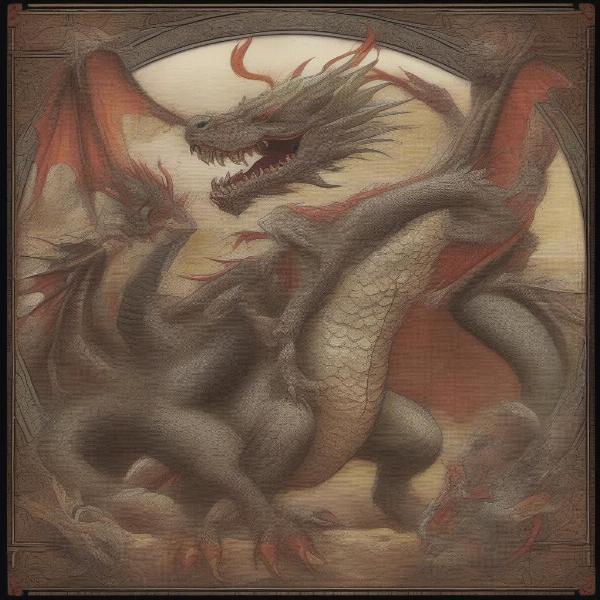 Dragons of the Dance of the Dragons
Dragons of the Dance of the Dragons
Long-Term Consequences of the Dance of the Dragons
The Dance of the Dragons left a lasting impact on Westeros. The war decimated the Targaryen dragon population, crippling their military strength for generations to come. The realm suffered immense losses and widespread devastation. The political landscape was irrevocably altered, setting the stage for future conflicts and instability.
The Diminishment of Dragon Power
The sheer number of dragons lost during the Dance of the Dragons significantly weakened the Targaryen dynasty. The near extinction of dragons was a critical factor contributing to their eventual downfall centuries later. This loss impacted the balance of power in Westeros, opening up vulnerabilities that other houses began to exploit.
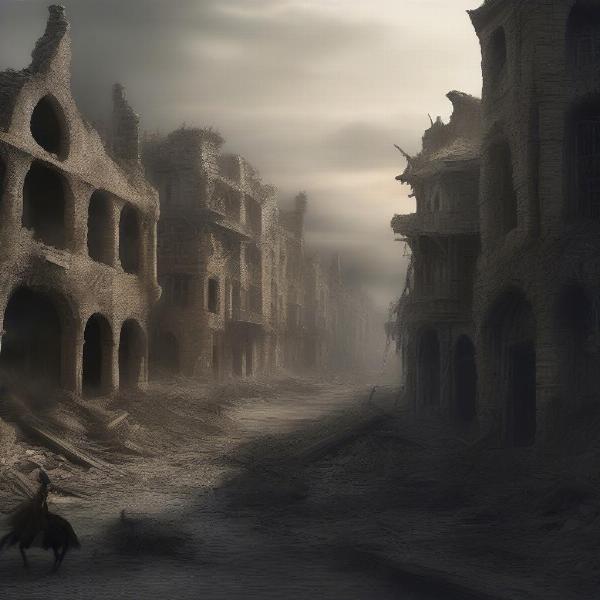 Aftermath of the Dance of the Dragons
Aftermath of the Dance of the Dragons
What was the significance of the Dance of the Dragons?
The Dance of the Dragons was significant because it fundamentally altered the power dynamics of Westeros. It demonstrated the fragility of Targaryen rule, even with the formidable advantage of dragons. The war’s devastating consequences shaped the political landscape for generations to come, paving the way for future conflicts and internal struggles.
How did the Dance of the Dragons affect the Targaryen dynasty?
The Dance of the Dragons severely weakened the Targaryen dynasty, significantly reducing their numbers and almost wiping out their dragons. The resultant instability fueled internal power struggles and allowed other noble houses to challenge the Targaryen authority, setting the stage for future conflicts and eventual decline.
Who were the main combatants in the Dance of the Dragons?
The primary combatants were Rhaenyra Targaryen and her supporters against Aegon II Targaryen and his allies. This conflict involved many prominent houses and individuals in Westeros, resulting in a widespread civil war. The conflict highlights the long-standing struggles for power and control within the Targaryen family and its ramifications on the Seven Kingdoms.
“The Dance of the Dragons serves as a stark reminder of the destructive nature of ambition and the high cost of civil war,” notes renowned Westerosi historian, Maester Aemon Targaryen. “The decimation of the Targaryen dragons and the widespread devastation across the realm highlight the consequences of unchecked power struggles.”
“The legacy of the Dance of the Dragons continues to shape the political landscape of Westeros long after the smoke has cleared,” observes Lady Selyse Florent, a respected political analyst. “The war’s impact on the balance of power and the lingering distrust among noble houses resonate through subsequent generations.”
“The Dance of the Dragons wasn’t just a war for the Iron Throne; it was a war for the very soul of Westeros,” adds Grand Maester Pycelle, a veteran of several political upheavals. “The decisions made during this conflict had profound and lasting implications that reverberate even into the present.”
The Dance of the Dragons in Game of Thrones
The Dance of the Dragons is more than just a historical event; it serves as a crucial backdrop for understanding the characters, motivations, and plotlines within Game of Thrones. The echoes of this devastating conflict reverberate throughout the series, influencing the actions and decisions of characters even centuries later. Understanding the Dance of the Dragons enriches the viewer’s or reader’s understanding of the complex political landscape and the characters’ motivations.
Conclusion
The Dance of the Dragons remains a pivotal event in the history of Westeros, fundamentally altering the political landscape and irrevocably shaping the fate of the Targaryen dynasty. Its impact is felt throughout the Game of Thrones narrative, adding layers of depth and complexity to the story. Understanding the key players, their motivations, and the devastating consequences of this civil war provides a crucial foundation for appreciating the nuanced intricacies of the Game of Thrones world. So, dive deeper into this fascinating historical event – your understanding of Game of Thrones will be enriched significantly! Share this comprehensive guide with fellow fans to deepen their understanding of the Dance of the Dragons mentioned in Game of Thrones!
